viSparsh - Helping the Blind Navigate
A team of innovative engineers have been working on a haptic-feedback device to assist the visually impaired to navigate around obstacles using an MS Kinect and Panda board, for machine vision and image processing and an mbed for driving the haptic-feedback.
Jatin Sharma, and Rolly Seth have written a blog about their project and the challenges they have faced.
wrote:
About viSparsh
"viSparsh" is a fusion of two words, " vision" and "sparsh"(touch), which depicts the purpose of the project to aid visually impaired people through the sense of touch. A team of three Young India Fellows Jatin Sharma, and Rolly Seth are developing this haptic belt under the tutelage and mentorship of Prof. Rahul Magharam, Director mLAB, University of Pennsylvania’s School of Engineering and Applied Science.
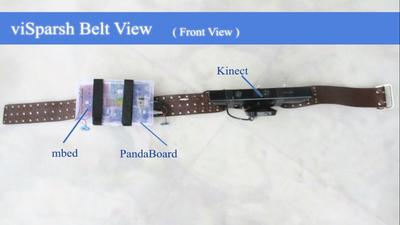 | 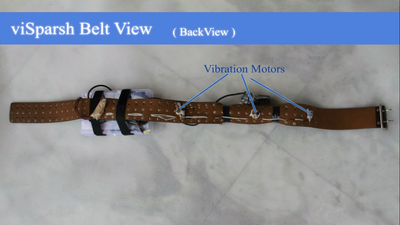 |
What is the focus of the project?
The focus of the viSparsh project is to create a haptic (touch-based feedback) belt for the blind with a simple goal that a blind person can avoid obstacles that are on and above ground height. This belt has an infrared optic sensor that projects thousands of dots in the 3-12 feet distance to determine what obstacles are present. Based on the proximity and relative direction of the obstacle to the wearer, a series of vibrators on the belt alert the wearer of the presence of obstacles around them. This system is lightweight, low-cost (Rs 5000), easy to use, non-conspicuous and also frees up the ears and hands of the blind person. The system provides a 160 degree view of the environment and is complementary to the limited reach of the walking stick. It also does not require any additional infrastructure in the environment.
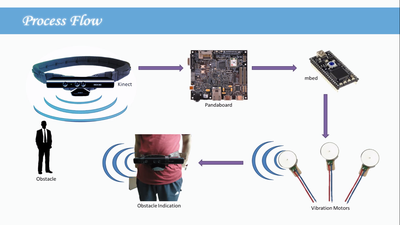
What kind of field work was/is done?
We have evaluated the belt in different work environments. The first type of evaluation is in a room with obstacles placed at fixed positions. This allowed us to measure the obstacle tracking error, the guidance algorithms in the presence of multiple obstacles and also obstacles of different sizes and at different heights. We have evaluated the usability, battery life and overall response with multiple blind persons. The second type of tests is in a "real-world" scenario with the wearer walking through a busy corridor and a busy room with many people. The response from the blind persons has been very positive both with respect to the wearability and the natural touch-based feedback. We plan to deploy more units with more compact on-board electronics in the near future.
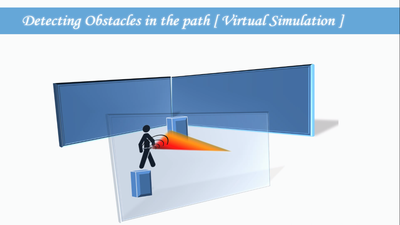 | 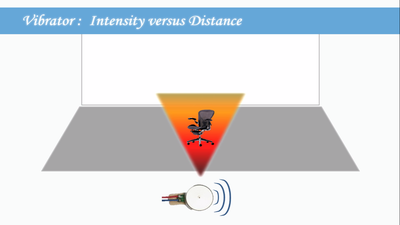 |  |
Problems Faced:
- Being the founding batch of The Young India Fellowship Programme we don’t have access to a proper lab setup which initially taxed us. But continuous support from YIF admin made possible for us to setup a small lab ‘eCapsule’ in our hostel room and kick-start the project.
- From screwdriver to multimeter to Kinect everything was to be procured and it took much time and effort. Also many things were not available in the local market and were to be ordered online which made us to wait for the deliveries.
- We required Pandaboard for our project which was not available for more than a month then. Fortunately, Texas Instrument gifted us one within a week.
- It took us time to install Kinect libraries and OpenNI on Pandaboard. There were many errors we faced and we had to find the fixes. [These can be found on our project blog]
What kind of an impact can the haptic belt make for people who are visually impaired?
The everyday life of a blind person is often taken for granted and the only navigation help is the walking stick. The stick, while effective, has limited reach and often does not detect obstacles above ground. Our focus in this project is to make a technology-packed device that is affordable to the average Indian and easy to use with just 5 minutes of training. While our focus is on the technological aspects, we strongly believe that technology is a means and must be complemented with user-based feedback with extensive evaluation and field tests. Our team logs every sentiment the blind person wearing the haptic belt gives us and we take their feedback very seriously. Our eventual goal is to deploy several hundred of these belts to everyday users so we can make a positive impact one person at a time.
More info please visit our blog: http://www.visparsh.blogspot.com/

Well done guys and thank you very much of the guest blog. Great to see an mbed used in such a inventive project, we hope it has helped you prototype your design concept, and hope that your belt eventually helps blind people all over the world!
3 comments on viSparsh - Helping the Blind Navigate:
You need to log in to post a discussion

Very Cool prototype, but maybe the LPC1768 is an overkill, the LPC11U24 may be a better option since you are using batteries